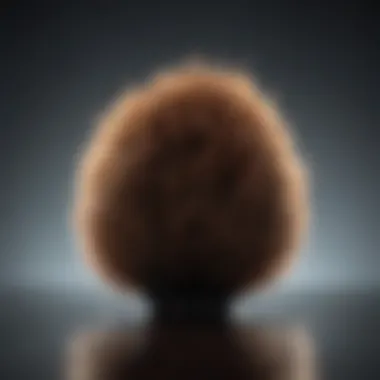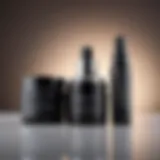Hair Color Options That Preserve Hair Health


Intro
Hair color often acts as an expression of individuality, allowing people to showcase their personal style. But, this pursuit of vibrant hues often comes at a cost to the health of our hair. With the right knowledge, however, it is possible to achieve stunning colors without compromising the integrity of your locks. This article takes a compelling look at different coloring techniques and products that aim to keep hair healthy while ensuring your strands look amazing. It's not just about changing your color; it’s about understanding how to do so without the heavy price of damage.
Fashion Trends
When we discuss hair color trends, we must consider how they flow in tandem with the latest runway showcases and seasonal styles. The modern focus is on colors that enhance one's natural beauty while nourishing the hair, creating a harmonious balance between fashion and care.
Runway Highlights
Recent fashion weeks have highlighted a shift towards more organic shades—think earthy tones like rich auburns or soft blondes that almost mimic the sun-kissed look. Models strutted down runways with hues that were not only striking but seemed to glow from within, signaling that health is the new chic.
Seasonal Must-Haves
As summer heats up, pastel hues are taking center stage. Soft lavenders, mint greens, and baby pinks are trending, yet they also raise questions about durability and hair health. Choosing semi-permanent dyes made with conditioning formulas ensures these vibrant shades stay bright without the usual damage of traditional coloring.
Celebrity-inspired Looks
Celebrities continually inspire hair trends, from classic shades to bold transformations. Recently, many stars have opted for color without the commitment. For instance, Jennifer Aniston’s subtle balayage highlights showcases how to beautifully lighten hair while keeping it healthy. These trends focus on maintaining shine and reducing breakage, showcasing a collective move towards mindful beauty.
Key Point: Many celebrities now favor hair colors that focus on low maintenance and health preservation rather than dramatic, damaging changes.
Beauty Tips and Tricks
To maintain hair health while experimenting with color, certain practices and products can work wonders. Incorporating the right hair care routine can easily complement any color choice, making sure that what you're striving for on the outside reflects a well-cared-for inside.
Skincare Regimens
While it's easy to focus solely on hair products, skincare techniques also play a milestone role. Using a moisturizing shampoo that is free from sulfates and parabens helps to maintain color and protect hair’s natural moisture. Additionally, always follow up with a deep conditioning treatment to restore shine.
Makeup Tutorials
Even makeup routines can indirectly influence hair appearance. Choosing complementary color palettes can draw attention away from damaged areas and create an overall pulled-together look. Soft, warm tones can help highlight healthy strands, leading to a more polished appearance.
Hair Care Secrets
A few undisputed hair care secrets include:
- Regular Trims: Keeping your ends fresh reduces split ends which can worsen damage.
- Cold Rinse: Ending your wash routine with a cold-water rinse seals cuticles and adds shine.
- Heat Protection: Always use a heat protectant spray before styling to shield hair from potential damage.
By implementing such care routines, you ensure that coloring your hair is both a fun and fulfilling experience, not just another point on the to-do list.
Epilogue
Choosing a hair color doesn’t have to spell disaster for your locks. Many modern techniques and products prioritize health without sacrificing aesthetic appeal. As trends evolve, let’s embrace a future where luminous hair is the result of mindful choices and sound knowledge.
Prolusion to Safe Hair Coloring
The journey to finding the perfect hair color often feels like a double-edged sword. On one hand, there’s a world of vibrant hues and personalized shades waiting to be explored; on the other, the looming threat of hair damage can cast a long shadow. This makes the understanding of safe hair coloring techniques more crucial than ever. Ultimately, embracing hair color should not come at the expense of hair health. The purpose of this section is to shed light on how to enjoy coloring while minimizing damage, ensuring that the end result is not just beautiful but healthy too.
In recent years, there’s been a noticeable shift toward safer hair color options that promise to keep hair looking its best. This is driven by both consumer demand for quality and the extensive research on how traditional dyes can wreak havoc on hair fibers. If you're thinking of refreshing your look without sacrificing the integrity of your locks, knowing about the products and methods available is key. Furthermore, understanding hair structure and the common pitfalls associated with coloring is essential in guiding your choices.
We’ll also touch on the importance of recognizing hair’s unique makeup. Not every hair type will respond the same way to color treatments, so personal knowledge can lead to more favorable outcomes. This section will serve as a solid foundation for those looking to embark on the hair coloring adventure with confidence and insight.
Understanding Hair Structure
Hair is more than just a collection of strands; it's a complex structure that requires careful thought before embarking on any coloring mission. The basic unit of hair, the hair shaft, is made up of three layers: the cuticle, cortex, and medulla. Each plays a vital role in the hair's strength and health.
- Cuticle: This is the outer layer, like a protective shield that keeps moisture in and harmful elements out. When hair is dyed, the cuticle's protective properties can be compromised, exposing the inner layers to potential damage.
- Cortex: It lies beneath the cuticle and contains the majority of strength and color. The cortex is where the magic happens during coloring. Dyes penetrate this layer to change hair color, but this can also weaken the hair if not done carefully.
- Medulla: The innermost layer, which isn’t present in all hair types, is thought to aid in insulation and strength, though its role in coloring is less significant.


To ensure your hair stays healthy, it’s crucial to consider these layers when choosing a color. Selecting products designed to minimize penetration into the cortex can help maintain its integrity.
Common Causes of Hair Damage from Coloring
There are a number of culprits that can lead to damaged hair following a coloring session. Familiarizing oneself with these can pave the way for better decision-making.
- Harsh Chemicals: Ammonia and peroxide are often used in hair dyes and can strip the hair of moisture. They can cause dryness, brittleness, and an overall unhealthy appearance.
- Overprocessing: Repeated coloring, particularly with permanent formulas, can lead to severe degradation of the hair shaft. Moderation is key.
- Lack of Preparation: Failing to properly condition hair before dyeing can lead to extra absorption of chemicals. A well-moisturized canvas is essential.
- Ignoring Aftercare: Neglecting post-color treatments can exacerbate damage. Regular conditioning treatments help retain moisture and repair damage.
In summary, a deeper understanding of hair structure and the factors that contribute to damage arms you with the information needed to make informed choices. Whether it’s choosing the right product or technique, knowledge in this arena can make all the difference in achieving not only a beautiful new hue but also in sustaining healthy, vibrant hair.
Types of Hair Coloring Products
When it comes to selecting hair color options that prioritize health, it’s important to understand the various types of hair coloring products available. Each category offers different benefits, risks, and considerations. Choosing the right one can make all the difference between vibrant color and fragile, damaged hair. If you want non-damaging results, knowing what’s beneath the surface matters.
Permanent Hair Color
Permanent hair color is often the go-to choice for many individuals seeking long-lasting hues. It fundamentally works by penetrating the hair shaft and altering the natural color using a combination of ammonia and peroxide. While it achieves exceptional results, it can visit heavy-duty stress on your strands, leading to dryness and breakage.
- Pros: This type provides rich, full coverage, especially for gray hair. Once applied, it lasts until the hair grows out or you choose to dye again. It allows for endless color options, making it a versatile choice for anyone looking to change their look.
- Cons: The permanence can be a drawback if you want to frequently switch things up. Moreover, the harsh chemicals can compromise hair health over time, leaving it brittle and more susceptible to damage.
In search of relatively kinder formulations, look for brands that offer ammonia-free permanent hair colors. These options can provide the same bold coverage with reduced damage potential.
Semi-Permanent Hair Color
Semi-permanent hair color is like the middle child in the hair dye family—balancing between temporary and permanent choices without packing too much of a punch. It doesn’t penetrate the hair, instead coating the outer layer, which means less potential for damage. Typically, these dyes last through several washes but tend to fade more quickly than their permanent counterparts.
- Pros: They’re great for people experimenting with new colors or those looking to boost fading hues. Semi-permanent colors can enhance shine and even out hair tone without the commitment.
- Cons: While not as long-lasting, these colors require more frequent touch-ups. Some may still contain damaging agents, so it’s wise to check ingredient labels.
This form of color is particularly beneficial for blending gray hair without sacrificing the health of your strands. It can smooth out those wiry hairs that seek to stick out.
Temporary Hair Color
Temporary hair color is a fun, no-strings-attached option for those wanting a quick transformation. It’s typically used for special occasions or when you simply want to switch it up just for a day or two. These products sit on the hair’s outer surface and can be easily washed out with shampoo.
- Pros: They present a risk-free way to experiment with colors without any long-term damage. If you fancy trying out vibrant, bold shades—think blues, pinks, or greens—temporary dyes can satisfy this whim without the need for commitment.
- Cons: The downside is that the color will wash out quickly, often not lasting beyond a few shampoos. Additionally, some temporary colors can leave buildup if not cleansed properly.
Temporary hair colors generally include products like hair chalks or sprays, allowing easy application without the use of chemicals that can yank your hair out of shape.
Natural Hair Dyes
Natural hair dyes are a rising star in the realm of hair color, especially for eco-conscious individuals. Made from plant-derived ingredients, these dyes present a safer alternative, limiting exposure to chemicals that can wreak havoc on hair integrity. Common options include henna, indigo, and various vegetable-based colors.
- Pros: These dyes can provide nourishment alongside color. For example, henna not only dyes hair a rich tone but can also strengthen your tresses and enhance shine. They are generally easier on sensitive scalps, making them a popular choice for those prone to reactions from chemical dyes.
- Cons: The color payoff can vary significantly and may require a longer application time. Also, it may not provide the same level of coverage as traditional dyes, especially for gray hair.
Natural hair dyes, while potentially more labor-intensive, create a holistic approach to coloring, marrying beauty with well-being. As you embark on your hair coloring journey, always weigh the options. The right choice hinges on what aligns with your needs while keeping hair health at the forefront.
Innovative Hair Coloring Techniques
In the quest for vibrant colors that don't strip away hair integrity, innovative hair coloring techniques play a pivotal role. These methods allow individuals to express themselves through color while ensuring healthier, more resilient hair. Unlike traditional full-color processes, these advanced application techniques focus on subtlety, gradients, and strategic placement of color, often reducing overall exposure to harmful agents in hair dyes.
Benefits of Innovative Techniques
One significant benefit is the minimized need for harsh chemicals. By utilizing methods that promote the natural layering of color like ombre or balayage, the hair undergoes less stress. Moreover, these techniques often allow for lower maintenance, as they grow out more gracefully compared to stark, solid colors.
Another aspect is versatility. Whether one is aiming for a soft, sun-kissed look or bold streaks, these techniques easily adapt to individual preferences and lifestyles. It’s about working with the hair's natural texture and color, enhancing it instead of overpowering it.
Considerations
However, it’s essential to consult with a professional hairstylist, particularly for complex styles such as balayage, as the application can be intricate. Additionally, for anyone looking to switch to these innovative methods, it’s worth noting that while they are often less damaging, they still require proper care and maintenance to keep hair looking its best.
Ombre and Balayage Techniques
The ombre and balayage techniques have gained popularity in the hair industry, thanks to their ability to create depth and dimension without sacrificing hair health. Ombre, characterized by a gradual lightening from the roots to the ends, offers a striking yet low-maintenance option. On the other hand, balayage employs a freehand painting technique, allowing the stylist to tailor highlights and lowlights according to the client’s hair structure and desired look.
The process is less rigorous than traditional dyeing, which often necessitates bleaching hair entirely. With these methods, the focus is on highlighting specific sections rather than saturating all the strands, which can be less damaging. This nuanced approach means fewer chemicals in the hair at once, resulting in healthier hair overall.


Aftercare Tips
To keep that freshly colored hair looking sharp, it’s crucial to invest in hydrating shampoos and conditioners. Look for sulfate-free products that nourish while protecting your new color. Regular deep conditioning treatments will also help maintain moisture levels, making sure your hair remains as soft as a cloud.
Foil and Lamp Techniques
Foil and lamp techniques stand out as some of the most precise methods for achieving vibrant results without overwhelming the hair. Foil techniques involve wrapping sections of hair in foil to isolate them during the dyeing process, which enhances control over the application and minimizes mess. This method is especially beneficial for those opting for high contrast or vibrant hues, giving a more polished finish.
Lamp techniques, while less common, use light to activate color processing. This approach can help achieve brighter results with less exposure to damaging agents, allowing for an even application across sections. Both methods reduce the exposure time to chemicals, which ultimately supports healthier hair.
Strategic Selection
When considering these techniques, the selection process for the right shade is vital. It's essential to select colors that complement your skin tone and hair texture for a seamless look. Additionally, opting for a trained professional who understands the subtleties of these techniques ensures the best possible outcome.
In summary, innovative hair coloring techniques like ombre, balayage, foil, and lamp methods provide a way to express personal style while honoring the health of your hair. By exploring these options, you can achieve dazzling colors that enhance your look without compromising the integrity of your beautiful locks.
Ingredients to Avoid in Hair Color
Choosing the right hair color can feel like navigating a minefield, particularly when you’re keen on retaining your hair’s health. It’s not just about the color itself, but the ingredients contained within those products that can profoundly impact the integrity of your locks. Understanding which ingredients to steer clear of can greatly influence not just the look of your hair, but also its overall well-being over time.
Harsh Chemicals Known to Damage Hair
Many conventional hair dyes are packed with a range of harsh chemicals that, while effective for coloring, can wreak havoc on your strands. These include:
- Ammonia: This compound is commonly used in hair dyes to open up the hair cuticle and allow dye penetration. However, it can lead to dryness and brittleness, leaving hair looking dull and lifeless.
- Hydrogen Peroxide: A bleaching agent that’s harsh on hair, hydrogen peroxide strips away not only color but essential oils, often resulting in weak, damaged strands.
- Parabens: Found in many cosmetics and personal care products, parabens are used as preservatives. While they prevent bacterial growth, they can irritate the scalp and contribute to hair health issues.
- Resorcinol: This ingredient, often found in darker hair color formulas, can be irritating to the skin and has been associated with various other health risks.
Using products containing these chemicals can lead to cumulative damage, making your hair more susceptible to further issues such as breakage and split ends. Stepping away from these ingredients is a step toward healthier hair.
Alternatives to Traditional Hair Dyes
If you wish to indulge in color without compromising on the health of your hair, consider alternatives that offer a more gentle approach. Here are a few to explore:
- Plant-Based Dyes: Henna and indigo are centuries-old natural dyes that provide rich color without damaging chemicals. They also nourish the hair and scalp, promoting healthy growth.
- Gluten-Free Variants: Some brands focus on using ingredients that are gluten-free and devoid of harmful chemicals. Opting for these can reduce the chances of irritation, especially for those who may have sensitive skin.
- Organic Hair Color: Many companies now offer organic dyes made from natural and non-toxic ingredients. These not only provide color but also often include nourishing elements like essential oils and plant extracts.
- DIY Recipes: Crafting your own hair dye from natural ingredients at home can be both fun and rewarding. Ingredients like beet juice for a reddish hue or chamomile tea for a subtle lightening effect can be both effective and safe.
By choosing these alternatives, you not only color your hair but also pamper it, keeping damage at bay. Avoiding harsh chemicals opens up so many possibilities, giving you the freedom to experiment with color while promoting healthier hair.
Takeaway: When coloring your hair, knowledge is power. Steering clear of damaging ingredients is crucial for maintaining vibrant, healthy locks, ensuring that your hair colors not just your look but also complements the overall health of your tresses.
Tips for Healthy Hair Coloring
Maintaining hair health while coloring is an essential consideration for anyone who enjoys changing their hair color. The journey to vibrant locks shouldn't come at the expense of hair integrity. After all, what's the point of a dazzling hue if your strands are left frayed and sad? Here's the rundown on some crucial tips and practices that can safeguard your hair from damage, ensuring your beauty game stays strong.
Preparing Hair for Coloring
Before diving into the coloring process, a little prep work can go a long way. Here are some key steps to take to make sure your hair is ready:
- Hydration is Key: Hydrating your hair a week prior is vital. Think about it like fasting before a big feast. Use deep conditioning treatments or masques to restore natural moisture. Products like SheaMoisture Raw Shea Butter Restorative Conditioner can revitalize your strands.
- Trim Split Ends: It’s silly to paint over damaged wood, right? A simple trim helps to remove those split ends. Regular haircuts maintain your hair’s texture, creating a smoother canvas for coloring.
- Limit Wash Days: Try not washing your hair the day before coloring. Natural oils form a protective barrier that can reduce irritation from chemicals in the dye.
- Test Your Products: If you are trying out a new dye, always perform a patch test. This step prevents unexpected allergic reactions that could ruin your whole coloring plan.
Post-Coloring Care and Maintenance
Once the coloring is done, the focus shifts to how to maintain the new hue while keeping your hair healthy:
- Use Sulfate-Free Cleansers: Washing hair with the right shampoo is crucial. Opt for sulfate-free options to retain moisture and color longevity. Brands like Olaplex No. 4 Bond Maintenance Shampoo are designed for color-treated hair, minimizing fade.
- Gentle Handling: Post-color, your hair may be a bit more delicate. Use a wide-tooth comb and be gentle when styling. Pulling while wet can lead to unnecessary breakage.
- Regular Deep Conditioning: Incorporate a weekly deep conditioning treatment into your routine. This replenishes moisture that could be lost in the coloring process.
- Protect from Heat: If you're styling with heat tools, use a protectant spray first. High temperatures can be particularly harsh on colored hair, making protection essential.
"Investing in your hair is not an expense; it's an investment in your health and confidence."
- Routine Touch-ups: Plan for routine touch-ups to avoid color build-up and keeping your hair in top shape. This doesn’t just beautify but helps in maintaining structure and shine to your locks.
By following these tips, you can enjoy the fun and excitement of hair coloring while prioritizing the long-term health of your hair. After all, a healthy scalp and well-maintained strands lead to even more stunning results.
Professional vs. At-Home Hair Coloring
When it comes to transforming your hair color, a significant decision arises: should you opt for professional services or tackle it yourself at home? This choice can greatly impact not only the outcome but also the health of your hair. Let's delve into both paths to see their distinctive attributes.


Advantages of Professional Coloring
Choosing a professional stylist to dye your hair offers several commendable advantages:
- Expertise and Experience: Professionals come equipped with training and a wealth of experience. They know how to assess your hair's condition, pigment needs, and desired outcomes. This understanding allows them to customize the color that suits you best.
- Quality Products: Salons often utilize high-quality products that are less damaging compared to many home kits. These products typically have formulas enriched with conditioning agents, which can help in maintaining the health of your hair post-color.
- Advanced Techniques: Stylists are well-versed in various coloring techniques such as balayage, foiling, and ombre. These methods, when executed correctly, can minimize damage and enhance the dimensionality of the color.
- Precision: The attention to detail that professionals bring can't be understated. They ensure even application and are skilled at blending colors, leading to a flawless appearance.
Having a trained eye to execute the perfect shade can often save you from potential regrets of a DIY misstep.
DIY Hair Coloring: Pros and Cons
Taking the plunge into at-home hair coloring has become a familiar territory for many.
While it can be a cost-effective and convenient option, there are both upsides and downsides.
Pros:
- Cost Efficiency: One of the most apparent benefits is saving money. DIY kits are often significantly cheaper than salon services, allowing budget-conscious individuals to keep their hair game strong without breaking the bank.
- Convenience: You can color your hair at your convenience, avoiding the need to book appointments or adhere to a stylist’s schedule.
- Control Over the Process: Many find joy in taking the reins of their hair color choice, allowing for a more personal expression of style and creativity.
Cons:
- Risk of Damage: Proper application requires skill. Many novices end up with streaky colors or lifeless locks due to uneven application or over-processing.
- Color Mismatch: Predicting the final result can be an absolute gamble, especially with box dyes that may not replicate the depicted shade.
- Limited Techniques: While instructions are included, the ability to perform advanced techniques like balayage is often missed.
Overall, the choice between professional and DIY hair coloring will boil down to personal preference, budget, and desired results. Weighing the pros and cons carefully can ensure you embark on the right path to achieve that vibrant, healthy hue you’re aiming for.
Trends in Hair Color for the Modern Individual
Understanding current trends in hair color plays a pivotal role in grasping the essence of personal style today. As people seek to express their identity and individuality, the pursuit of hair color that reflects one’s personality has become more important than ever. Trends do not just change color palettes; they influence how we view beauty, self-care, and personal expression. This section will dive into the notable trends in hair color that promise to keep your locks vibrant while ensuring they remain healthy.
Natural and Organic Hair Color Trends
In recent years, natural and organic hair color trends have surged, capturing the interest of environmentally conscious consumers and beauty aficionados alike. This shift towards gentler options stems from a growing awareness of hair health as well as overall wellness. Natural dyes, such as henna, indigo, and chamomile, are not only celebrated for their minimal impact on hair damage but are also rich in nurturing properties that can enhance shine and texture.
Some key benefits of opting for natural hair colors include
- Reduced Chemical Exposure: Less risk of skin irritation and allergic reactions associated with synthetic dyes.
- Eco-Friendly Impact: Many natural dyes come from sustainable resources. This aligns with the broader movement towards sustainability in beauty and fashion.
- Vibrant and Unique Results: Natural colors often yield richer, more complex tones that develop beautifully over time.
As interest continues to rise, brands are responding to the demand with innovative formulations that combine the best of nature without sacrificing color payoff. Organic options eliminate harsh ingredients, meaning that your strands are unlikely to suffer from dryness or brittleness post-coloring. People are not just coloring their hair anymore—they are choosing to treat their hair as an extension of their beliefs and values.
Bold Colors without Compromise
On the flip side, a noticeable trend is the inclination towards bold colors without compromise. Individuals are increasingly embracing vivid hues, such as electric blues, fiery reds, and pastel pinks, without the worry of damaging their precious tresses. This trend effectively showcases a desire for self-expression and creativity, allowing hair to become a canvas of personal artistry.
The pursuit of bold colors does not have to sacrifice health. Several modern products contain advanced formulations that protect hair integrity while accommodating those daring shades. Here are some considerations for achieving bold colors while maintaining hair quality:
- Color-Depositing Conditioners: These products enrich your strands with color while conditiong them at the same time.
- Sulphate-Free Shampoos: Shampoos free from harsh chemicals help maintain vibrant color and protect oils essential for hair health.
- Regular Treatments: Incorporating deep conditioning masks into your routine aids in replenishing moisture that can be stripped during the coloring process.
"Vivid hair colors can be one of the most empowering forms of self-expression. When choosing a bold look, always prioritize products that nurture and not just tint."
Combining creativity with care is a delicate balance, but it’s one that today’s hair enthusiasts are mastering with finesse. The evolution of hair coloring trends signifies a broader cultural shift towards embracing individuality without compromising well-being. This alignment of aesthetics and care continues to draw beauty lovers into the world of innovative hair color options.
Ending: Prioritizing Hair Health
Understanding the intricacies of hair coloring is crucial, not just for aesthetics but for maintaining the vitality of your locks. As we have discussed throughout this article, prioritizing hair health while engaging in coloring practices is essential for a balanced, vibrant appearance. Hair, being a delicate structure, is susceptible to damage from harsh chemicals and aggressive techniques. By selecting safe coloring options, individuals can enjoy an array of hues while keeping their hair in prime condition.
The benefits of prioritizing hair health are manifold. Not only does healthy hair look more vibrant, but it also holds color better and is less prone to breakage. When hair is treated well, it reflects light in a way that achieves a luminous finish. Furthermore, considering hair health promotes a long-term approach to hair care, cultivating resilience and reducing the need for frequent trims or treatments to mend damage. Thus, making informed choices while coloring can significantly impact overall hair integrity.
Future of Hair Coloring Innovation
The future of hair coloring promises exciting advancements, especially as consumers become more knowledgeable about sustainable practices and product safety. Innovations are already emerging in the realm of plant-based dyes and formulations that minimize damage while maximizing efficacy. Brands are increasingly focused on leveraging technology to create products that make coloring a guilt-free endeavor. For instance, the inclusion of natural oils and botanical extracts helps fortify and nourish hair during the coloring process.
Another development to keep an eye on is the rise of customizable hair color products. These allow individuals to blend shades at home tailored uniquely to their preferences. Such innovations not only offer endless personalization but also significantly reduce the need for harsh chemicals traditionally used in permanent dyes. As companies continue to innovate, we can expect a broader acceptance of eco-friendly and health-conscious products without compromising on color vibrancy.
Final Thoughts on Hair Care and Coloring
Educational resources, such as community forums on Reddit or informational sites like Wikipedia and Britannica, offer extensive knowledge and user experiences that can guide those exploring new coloring options. Always seek out products with cleaner ingredients and consult with professionals who understand the balance between artistry and hair health.
Ultimately, making informed decisions about hair color will not just enhance your appearance but also foster a holistic approach towards beauty that aligns with health and well-being. Remember, your hair tells a story, so make sure it’s a good one!















